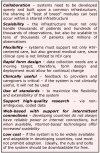AMPATH Medical Record System (AMRS): collaborating toward an EMR for developing countries
- PMID: 16779088
- PMCID: PMC1560633
AMPATH Medical Record System (AMRS): collaborating toward an EMR for developing countries
Abstract
Millions of people are either living with or dying from HIV/AIDS; most of this living and dying is taking place in developing countries. There is an immediate need for electronic medical record systems to help scale up HIV/AIDS prevention and treatment programs, reduce critical human errors, and support the research necessary to guide future efforts. Several groups are working on this problem, but most of this work is occurring within silos. To be more effective, we must find ways to collaborate. We describe a system built on the 30+ years of experience at Regenstrief Institute to serve as the seed for building toward a common infrastructure. We discuss the design goals, data model, and implementation of a data entry component. Further details are available online at amrs.iukenya.org.
Figures




References
-
- McDonald CJ. Protocol-based computer reminders, the quality of care and the non-perfectability of man. New England Journal of Medicine. 1976;295(24):1351–5. - PubMed
-
- Dexter PR, Perkins S, Overhage JM, Maharry K, Kohler RB, McDonald CJ. A computerized reminder system to increase the use of preventive care for hospitalized patients. N Engl J Med. 2001;345(13):965–70. - PubMed
Publication types
MeSH terms
Grants and funding
LinkOut - more resources
Full Text Sources
